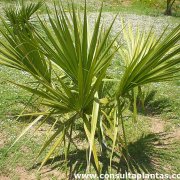Care of the palm tree Sabal palmetto or Carolina palmetto |
|
The genus Sabal, family Arecaceae, comprises about 15 species of palm trees native to the region between the southern United States and northern South America. Some species are: Sabal palmetto, Sabal uresana, Sabal mexicana, Sabal minor, Sabal bermudana. Common names: Carolina palmetto, Cabbage palmetto, Cabbage palm. This species is native to Cuba, the southeastern US, and Bermuda. They are palm trees with a thick trunk (up to 60 cm/1.96 feet in diameter) that reach 20 meters (65.6 feet) in height. The leaves have a spineless petiole, fan-shaped, have 40-60 leaflets of 80 cm (2.6 feet) in length and are of an intense green color. The yellowish flowers appear in long branching inflorescences up to 2.5 meters (8.2 feet) in length. The fruits are small blackish drupes 1 cm (0.39") in diameter. Carolina palmetto is used in rockery, next to ponds and water courses, as isolated specimens and in small groups. It's ideal for Mediterranean coastal gardens. Sabal palmetto grows in full sun and semi-shade exposures. It resists frosts down to -14 ºC (6.8 ºF). Cabbage palm can grow in any type of soil but prefers clay calcareous soils with poor drainage. The planting is done in spring. Water regularly so that the substrate is always slightly damp; Cabbage palmetto resists drought and flooding well. Fertilize once a month with mineral fertilizer for palm trees in spring and summer to accelerate growth. Dry leaves can be pruned but it is not strictly necessary. Sabal palmetto is a very resistant plant to the usual pests and diseases. Carolina palmetto is propagated from fresh seeds sown in spring; they can germinate in 3-4 weeks. |
Images of the palm tree Sabal palmetto or Carolina palmetto |
Find plants
Sabal palmetto or Carolina palmetto | Care and Growing
© 2026 FavThemes
